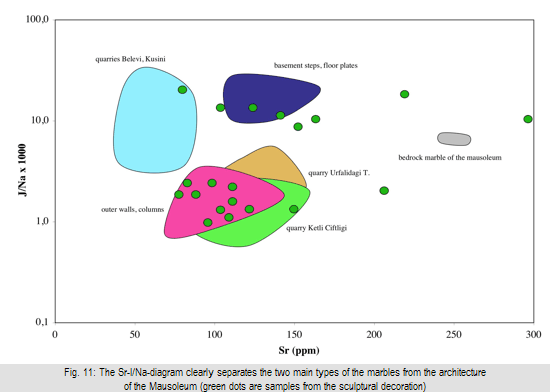In this paper the analyses of the chemistry of the inclusion fluids and extractable salts (crush-leach analyses) are used to characterize and distinguish marbles of the Mausoleum at Belevi nearby Ephesus. There are different types of marbles that had been mined in the area of Ephesus, with appreciable importance for the whole province (e.g. for the city of Pergamon) and which have not been characterized in sufficient detail so far. The main target was to study the marbles used for the Mausoleum and to investigate if these types of marble can be related to one of the different ancient quarries of this area. Furthermore samples from well-documented architecture were investigated.
The method presented below is expected to contribute substantially to the solution of the problem of the provenance of marbles and offers some fundamental advantages compared to different methods so far used for this purpose.
1. Selected methodology and experimental design
1.1 Sampling
Appropriate sampling for a multi-method approach for the investigation of the provenance of marbles is given by Moens et al. [1]. The samples taken for this study from different marble formations and quarries in the region of Ephesus are usually handspecimens, while the samples from loose and broken parts of the architecture of the Mausoleum are very different in size. Generally the size of a sample provides enough material for a multi-method investigation and is sufficient for the crush leach analysis, for isotope and chemical analysis. Not in every case (especially from the sculptural decoration) the size is big enough for the preparation of a thin section for petrographic investigations.
1.2 Crush-leach analysis
Sample preparation: Calcite as well as dolomite marbles are crushed to a grain size between 1 and 2 mm and repeatedly washed until no surface impurities can be traced.
Leaching procedure: A double distilled water leach is used for analyzing anions as well as cations. The samples are hand crushed using an agate mortar and pestle. 1 g of the cleaned sample and 5 ml of the leaching solution are transferred to the thoroughly cleaned mortar and crushed. The milky solution produced is filtered to separate the leachate from the ground quartz. In special cases smaller amounts of sample of approximately 0.2 g may be sufficient.
Analysis: A Dionex system (DX-500) with a micro-membrane suppressor is used for analysis of the anions. Li, Na, K, Mg, and Ca are analyzed by a Dionex ion chromatography system (DX-120) with autosuppression. Accuracy was tested by running standards and turned out to be at 5 % for element ratios (Na/Br, Cl/Br).
Because the degree of dilution for individual analyses is not known, the results are given as ionic ratios relative to Na multiplied by 1000. These ratios will not be affected by dilution of the inclusion fluids, efficiency of the crushing procedure etc. thus allowing a direct comparison of the analytical results.
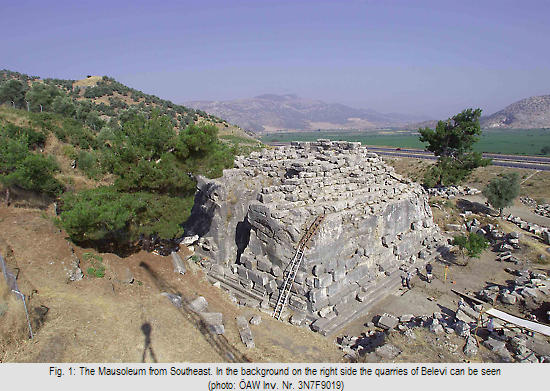
2. The Monument
3.4 The quarry Urfalidağı Tepesı
In the isotope diagram (fig. 10) and in tab. 1 the results obtained during this work are presented as well as the isotope field of some classical marbles [9]. Both marble type I and II from the Mausoleum at Belevi exhibit similar δ18O(PDB) and δ13C(PDB) numbers and cannot be differentiated on the basis of isotope analysis alone. Type I and II marbles plot close to the field of Ephesus I. Especially the heavy δ13C(PDB) numbers are not very common in the most important ancient marbles reported so far. Among the classical marbles from Greece and from Western Anatolia only the Parian, the Ephesus I and to a minor extent the Proconnesos marbles exhibit similar heavy carbon isotope compositions.
The Mausoleum at Belevi (fig. 1) is located 14 km northeast of Ephesus (next to the modern motorway from Izmir to Aydin) in the eastern part of the Kaystros-valley close to the ancient estates of the Ephesian sanctuary of Artemisia [2].
The architectural dimensions and the design of the elaborate decoration presenting (mainly in the sculptural décor) Greek and Persian elements in a programmatic demand suggest an erection in the late 4th to early 3rd century B.C. - probably for a distinguished highly respected historical person with wide political influence. As owner of the monumental tomb the Seleucid king Antiochos II. Theos ( 246 B.C. in Ephesus) as well as some potentates like Mentor of Rhodos ( before 336 B.C.) or (his brother) Memnon ( 333 B.C.) or Menandros ( short after 318 B.C.) are discussed [3]. Basically the date of the architectural ornamentations und of the ceramics provides an opportunity to identify the Mausoleum as the grave of king Lysimachos ( 281 B.C.) [4], but according to Pausanias and Appian, the Diadoche was buried in the Thracian town Lysimacheia [5]. Today it still remains unclear for whom the Mausoleum was built.
The geology of the area is dominated by a series of Cretaceous flysch metasediments including metapelites and layers of different types of marbles. A rock-core directly cut from the Cretaceous gray, banded marble of a mountain ledge and formatted in cubic shape by quarrying the flanks of the hill forms the center of the pedestal of the two-story monument. This shaping was also used to produce single blocks of gray marble for the architecture of the Mausoleum in non-visible parts. Hand-worked stones of a white, medium grained marble encased the core of formatted bedrock marble and gave the impression that the Doric-style pedestal with a height of 10.70 m [6]. was massively layered. A Doric frieze with plain metopes and a cornice concludes the pedestal and a false door worked into the middle of the north side accentuated the main front of the monument.
The upper level designed in Corinthian architecture was formed by a rectangular cella-like core-building surrounded by a peristasis. While the core building was created as an unroofed court, the peristasis was covered by a ceiling and a roof made of flat marble tiles. Coffer reliefs (formally intensively painted and adorning the panels of the ceiling) showed at the north side scenes with agonistic topics and on the three other sides a Centauromachy (with unusually fully armed Lapiths) [7]. On the roof long-winged liongriffins (symbols of the Persian kings) antithetically grouped around globular vases were situated along the four sides and life sized figures of horses together with a groom formed the ornamentation at the corners.
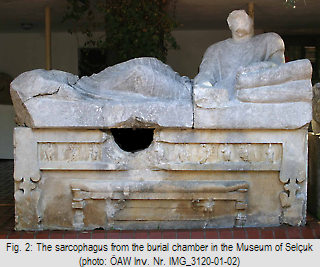 The burial chamber as central part of the Mausoleum is cut into the south side of the pedestal. The winning of the burial chamber possibly followed a tectonic structure in the marble resulting in a funnel-shaped cavity narrowing upwards. The marks of the workings in the grave definitely show that the winning was worked from top to the bottom. A monumental sarcophagus (fig. 2) with a reclining beardless male figure on the lid, which was formerly crowned with a wreath and held a bowl in its right hand, formed together with an almost life-sized statue of an Oriental characterized by its posture and its clothes as a royal Persian servant or page an iconographic unit representing a banquet-scene.
The burial chamber as central part of the Mausoleum is cut into the south side of the pedestal. The winning of the burial chamber possibly followed a tectonic structure in the marble resulting in a funnel-shaped cavity narrowing upwards. The marks of the workings in the grave definitely show that the winning was worked from top to the bottom. A monumental sarcophagus (fig. 2) with a reclining beardless male figure on the lid, which was formerly crowned with a wreath and held a bowl in its right hand, formed together with an almost life-sized statue of an Oriental characterized by its posture and its clothes as a royal Persian servant or page an iconographic unit representing a banquet-scene.
3. The investigated samples
Listed below there are the different groups of marbles that were distinguished on the base of petrography or/and on their function. Two main types of marbles can be observed at the Mausoleum: The Krepidoma of the Mausoleum and the paving tiles of the burial chamber (type I) and blocks encasing the pedestal as well as walls, columns, entablature etc. of the upper level (type II). Two quarries in close distance to the Mausoleum (Belevi and Kuşini) were sampled and investigated so far.
3.1 Krepidoma and paving tiles (type I)
This type of marble was used for the three steps of the Krepidoma of the Mausoleum (fig. 3) with one exemption on the uppermost step where in one case marble of type II was used. The marble plates of the paving of the burial chamber (fig. 4) are of the same type.
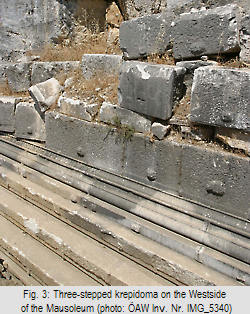
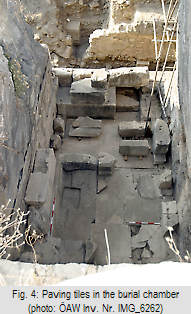
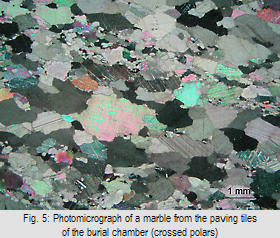 This type is a white, fine grained, relatively pure calcite marble with some deformation and subordinate schistosity. The maximum grainsize (MGS) is approx. 1 mm. The foliation planes are marked by the occurrence of muscovite and quartz.
This type is a white, fine grained, relatively pure calcite marble with some deformation and subordinate schistosity. The maximum grainsize (MGS) is approx. 1 mm. The foliation planes are marked by the occurrence of muscovite and quartz.
A very characteristic feature of this type of marble is the occurrence of dolomite aggregates in layers and elongated clusters of fine grained, idiomorphic dolomite crystals of a grainsize of about 0.2 mm (fig. 5).
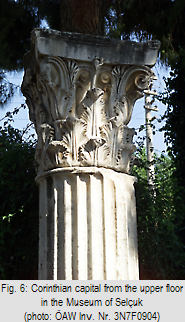 3.2 Walls, columns, entablature etc. (type II)
3.2 Walls, columns, entablature etc. (type II)
The blocks encasing the pedestal and the architecture of the upper level of the Mausoleum - including the columns (fig. 6) - are of one special type of white, medium grained marble.
Foliation and schistosity can neither be seen macroscopically nor under the microscope. The fabric of the rock is heterogranular. Calcite crystals with MGS of > 2mm 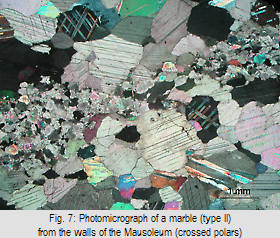 exhibit ± straight curved grain boundaries. A characteristic feature of this rock is that nests and lenses dominated by small dolomite grains (~ 0.x mm) occur in a granoblastic groundmass. In general, these small dolomite grains do not exhibit twin lamellae and show a clear rim and a dull core due to clusters of very small fluid inclusions in the centre of the dolomites (fig. 7).
exhibit ± straight curved grain boundaries. A characteristic feature of this rock is that nests and lenses dominated by small dolomite grains (~ 0.x mm) occur in a granoblastic groundmass. In general, these small dolomite grains do not exhibit twin lamellae and show a clear rim and a dull core due to clusters of very small fluid inclusions in the centre of the dolomites (fig. 7).
3.3 The quarry Ketli Çiftliği
A survey of the most important quarries in the area of Ephesus showed that the samples from the quarry Ketli Ciftliği (fig. 8) match very well the type II marbles of the Mausoleum. The quarry is located some 3.7 km NNW of the Mausoleum. The layer of white marble in a big quarry behind a farm is of appreciable thickness (up to 20 m). In strike traces of antique quarrying can be observed on a length of about 200 m. Due to the recent activities in connection with facilities of the farm etc. it is impossible to estimate the volume of marble mined in this quarry. The marbles for the architecture of the classical Artemision are attributed to this quarry [8].
The petrographic features of this marble are practically identical with those of the type II marble of the Mausoleum described above. Especially the same textures of small dolomite layers and lenses can be found also in these marbles (fig. 9).
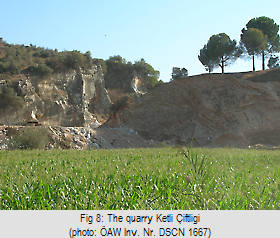
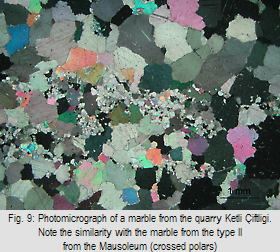
Petrographically the marbles from Urfalidağı Tepesı are very similar to those from Ketli Çiftliği although the average dolomite contents are generally much higher. Furthermore this marble exhibits more macroscopically visible impurities and sometimes grayish and black spots.
4. Results of stable isotope and fluid chemistry analyses
4.1 Results of the stable isotope analyses
There are several studies on the isotopic composition of the marbles of the region of Ephesus but the data presented are very heterogeneous and have often been presented only as compositional fields in the isotopic diagram without the complete analytical data of the single samples.
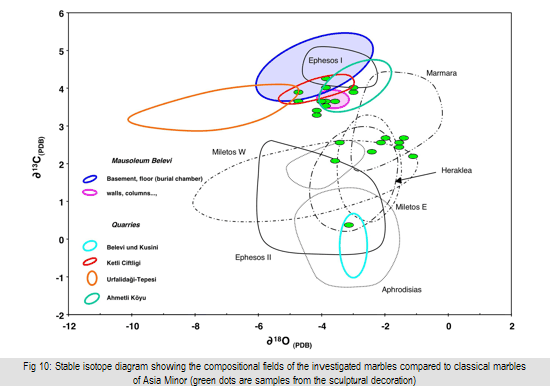
The marbles from the quarries of Belevi and Kuşini show practically identical composition in their stable isotope contents and cannot be distinguished exclusively on this basis. In the isotope diagram the compositional field of these quarries is in the range of the Ephesus II field. The marbles from the other investigated quarries (Ketli Çiftliği and Urfalidağı Tepesı) plot close to the Ephesus I field together with the marbles of the Mausoleum.
